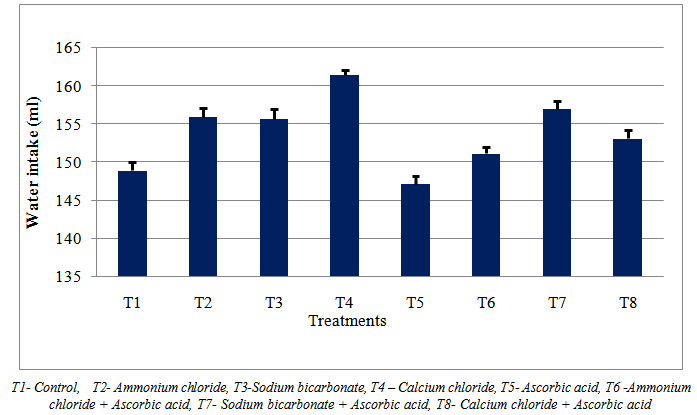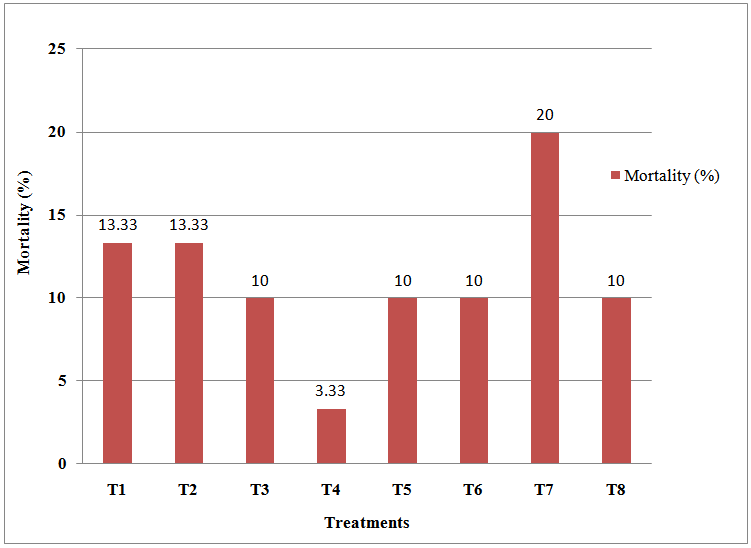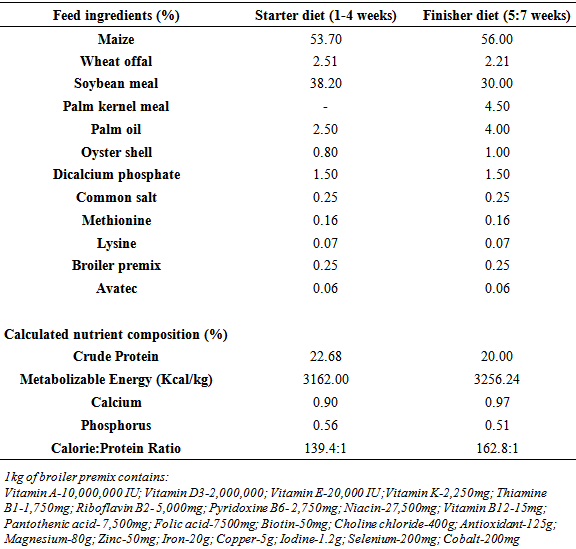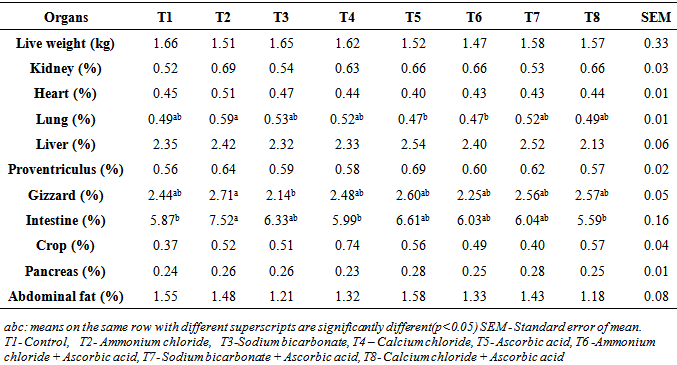| [1] | Ahmad T., Sarwar M. and Un-Nisa M., Ul-Haq A. and Ul-Hasa, Z. 2005. Influence of varying sources of dietary electrolytes on the performance of broilers reared in a high temperature environment. Anim. Feed Sci. Technol. 20, 277-298. |
| [2] | Daghir, N. J. 2008. Poultry Production in Hot Climates, 2nd Edition, Published by CAB International, Wallinford, Oxfordshire, UK, pp.387. |
| [3] | Nilipour, A. H. 2000. Modern broilers require optimum ventilation. World Poultry 16: 30-31. |
| [4] | Altan, O., A. Altan, M. Cabuk and H. Bayraktar. 2000. Effect of heat stress on some blood parameter in broilers. Turk Veternerlik Ve Hayvancilik Dergisi, 24: 2, 145-148. |
| [5] | Deyhim, F. and Teeter, R. G. 1991. Research note : Sodium and potassium chloride drinking water supplementation effects on acid-base balance and plasma corticosterone in broilers reared in thermoneutral and heat-distressed environments. Poultry Sci. 70: 2551-2553. |
| [6] | Yalcin S., P.Settar S. Ozkan and Cahaner. 1997. Comparative evaluation of three commercial stocks in hot vs temperate climates. Poult. Sci. 76:921-929. |
| [7] | Cier, D., I. Rimsky, N. Rand, O. Polishuk, N. Gur, A. Benshahan, Y. Frish and A. BenMoshe. 1992. The effects of supplementing breeder feeds with ascorbic acid on the performance of their broiler offspring. Proc. 19th World’s Poultry Congress, Vol. 1, 620-621. |
| [8] | Williams, P. 1996. Vitamin E in the control of heat stress. Rivista di Avicultura, 65(9): 25-29. |
| [9] | Teeter, R. G. and M. O. Smith. 1986. High chronic ambient temperature stress effects on broiler acid base balance and their response to supplemental ammonium chloride, potassium chloride and potassium carbonate. Poultry Sci., 65(9): 1777- 1781. |
| [10] | Branton, S. L., F. N. Reece, and J. W. Deaton. 1986. Use of ammonium chloride and sodium bicarbonate in acute heat exposure of broilers. Poult. Sci. 65:1659–1663. |
| [11] | Pardue, S. L., Thaxton, J. P. and Brake, J. 1985. Role of ascorbic acid in chicks exposed to high environmental temperature. Journal of Applied Physiology 58: 1511-1516. |
| [12] | Balnave, D. and I. Gorman. 1993. A role for sodium bicarbonate supplements for growing broilers at high temperatures. World’s Poult. Sci. J. 49:236–241. |
| [13] | Bains, B. S. 1996. The role of Vitamin C in stress management. World Poult. 12(4): 38-41. |
| [14] | Majekodunmi, B. C., Ogunwole, O. A. and Sokunbi, O. A. 2012. Effect of supplemental electrolyte and ascorbic acid on the performance and carcass characteristics of broiler raised during high temperature period in Nigeria. International J. of Poultry Science 11(2): 125-130. |
| [15] | Ogunwole, O. A., Oso, Y. A. A., Omotoso, R. R., Majekodunmi, B. C., Ayinde, B. O. and Oikeh, I. 2013a. Performance, carcass characteristics and meat physico-chemical properties of broiler chickens fed graded levels of supplemental ascorbic acid. Agric. Biol. J. N. Am., 4(4): 483-493. |
| [16] | Ogunwole, O. A., Oikeh, I., Majekodunmi, B. C., Ayinde, B. O. and Lawal T. T. 2013b. Blood profile of Broiler chickens as affected by diets supplemented with graded levels of Ascorbic acid. Ibadan Journal of Agric. Res. Vol. 9:211-217. |
| [17] | Majekodunmi B. C., Sokunbi O.A., Ogunwole O. A., and Adebiyi O. A. 2013. Influence of electrolytes and ascorbic acid supplementation on serum and erythrocytic indices of broiler chickens reared in a hot environment. Afr. J. Agric. Res. Vol. 8(8) pp-12-164. |
| [18] | Majekodunmi, B. C. 2014. Mitigation of heat stress in broiler chickens using ascorbic acid and electrolytes. PhD Thesis, Department of Animal Science, University of Ibadan, Ibadan, Nigeria. 185pp. |
| [19] | Oluyemi, J. A and Roberts, F. A. 2000. .Poultry production in Warm Wet Climates.2nd edition. Spectrum Books Ltd, Nigeria. |
| [20] | Yahav, S. and McMurtry, J. P. 2001. Thermotolerance acquisition in broiler chickens by temperature conditioning early in life- the effect of timing and ambient temperature. Poultry Science 80: 1662-1666. |
| [21] | SAS. 1999. SAS/STAT User's Guide. Version 8 for windows. SAS Institute Inc., SAS Campus Drive, Cary, North Carolina, USA. |
| [22] | Charles, D. R. 2002. Responses to the thermal environment. In: Poultry Environment Problems, A guide to solutions (Charles, D.A. and Walker, A.W. Eds.), Nottingham University Press, Nottingham, United Kingdom, pp.1-16. |
| [23] | Holik, V. 2009. Management of laying hens to minimize heat stress. Lohmann Information 44: 16 – 29. |
| [24] | Taweli al and R. N. and Kassab, A. 1990. Effect of dietary vitamin C on ascites in broiler chicks. International Journal of Vietnamese Nutritional Research, 60 (4): 366-371. |
| [25] | Balnave, D. and Olive, A. G. 1991. The influence of sodium bicarbonate and sulfur amino acids on the performance of broilers at moderate and high temperatures. Australian Journal of Agriculture Research 42, 1385–1397. |
| [26] | Takahashi, K. and Akiba, Y. 2002. Effect of oral administration of electrolytes additives on growth and some physiological responses in broiler reared in a high temperature environment. Asian Australian Journal of Animal Science, 15(9): 1341-1347. |
| [27] | Tanveer, A., Sarwar, M., Mahr, U. N., and Ahsan, U. H. 2005. Influence of varying sources of dietary electrolytes on the performance on broiler reared in a high temperature environment. Animal Feed Science and Technology,120(3/4): 277-298. |
| [28] | Withers, P. C. 1992. Animal Energetics. Page: 108 in: Comparative Animal Physiology. Saunders College Publishing, New York, NY. |
| [29] | Bottje, W. G. and Harrison, P. C. Celiac cyclic blood 1987 flow pattern response to feeding and heat exposure. Poult.Sci., 66: 2039-2042. |
| [30] | Stilborn, H. L., G. C. Harris, W.G. Bottje and Waldroup, P. W. 1988 Ascorbic acid and Acetylsalicylic acid (aspirin) in the diet of broilers maintained under heat stress conditions. Poultry Sci. 67(8): 1183-1187. |
| [31] | Puron, D., P. Santamaria and Segura, J. C. 1994. Effect of Sodium Bicarbonate, Acetylsalicylic and Ascorbic acid on broiler performance in a tropical environment, Journal of Applied Poultry research, 3: 141-145. |
| [32] | Smith, M. O., and R. G. Teeter. 1993. Carbon dioxide, ammonium chloride, potassium chloride, and performance of heat distressed broilers. J. Appl. Poult. Res; 2:61-66. |
| [33] | Smith, M. O., and R. G. Teeter. 1989. Effects of sodium and potassium salts on gain, water consumption and body temperature of 4 to 7 week old heat stressed broilers. Nutr. Rep. Int. 40:161–169. |
| [34] | Bonsembianate, M., G. M. Chiericato and Bailoni, L. 1988. The effect of sodium bicarbonate on the performance of broilers subjected to temperature and humidity stress. Poult. Absts.15: 1000. |
| [35] | Genedi, D. M. M. 2000.The role of some anti- stressors on layer performance during hot climate conditions. M.Sc., Thesis Faculty of Agriculture, Cairo University. |
| [36] | Pardue, S. L. and Thaxton, J. P. 1986. Ascorbic acid in poultry: a review. World’s Poult. Sci. J.; 42: 107-123. |
| [37] | Kutlu H. R. and Forbes, J. M. 1993. Changes in growth and blood parameters in heat-stressed broiler chicks in response to dietary ascorbic acid. Livestock Product Sci., 36, 335-350. |
| [38] | Belay, T., and R. G. Teeter. 1993. Broiler water balance and thermobalance during thermoneutral and high ambient temperature exposure. Poult. Sci.; 72:116–124. |
| [39] | Ahmad, M. M. and M. Sarwar Dietary electrolyte 2006. balance: implications in heat stressed broilers. World’s Poultry Science Journal: 62, 638-653. |
| [40] | Hayat, J., Balnave, D. and Brake, J. 1999. Sodium bicarbonate and potassium bicarbonate supplements for broilers can cause poor performance at high temperature. Br. Poult. Sci. ; 40: 411-418. |
| [41] | Onu, P. N. 2009. Growth performance, carcass characteristics and economic benefits of supplemental ascorbic acid on broiler starters exposed to heat stress. ARPN J. of Agric and Bio. Sci.; Vol. 4, No. 5. Pp 19-23. |
| [42] | Sobayo R. A., E. B. Oguntona, O. A. Osinowo, D. Eruvbetine, A. M. Bamgbose, O. A. Adeyemi, A. O. Lomola, E. N. Okeke and J. M. Usman. 2008. Effects of Ascorbic acid supplementation on the performance indices of starter pullets in a humid environment. Proceeding of the 33rd Annual conference of Nigerian society for Animal production.; Pp 428-430. |




 Abstract
Abstract Reference
Reference Full-Text PDF
Full-Text PDF Full-text HTML
Full-text HTML



